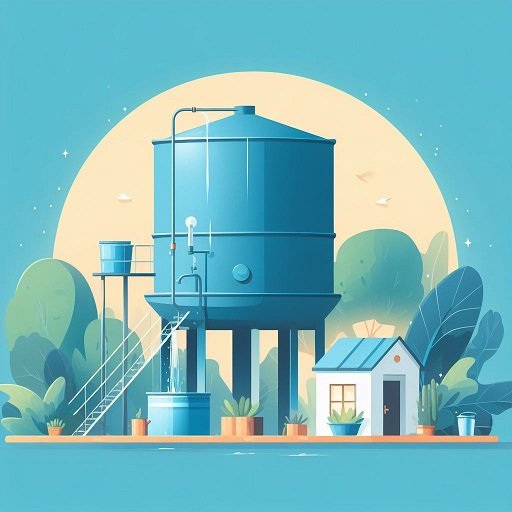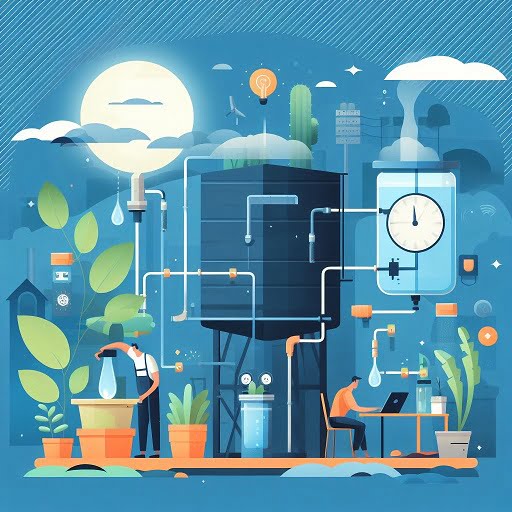Water is essential for life, but it can also be a source of disease and discomfort if it is not clean and safe. In Karachi, where water scarcity and pollution are major challenges, having a clean water tank is crucial for ensuring the health and well-being of your family and yourself.
Water tanks are used to store water for domestic or commercial purposes. They can be made of different materials, such as plastic, concrete, steel, or fiberglass. They can also vary in size, shape, and capacity. However, regardless of these factors, water tanks need regular maintenance to prevent contamination and deterioration.
The purpose of this article is to provide you with some useful information on how often you should clean your water tank in Karachi, what factors influence the cleaning frequency, how to clean your water tank yourself or hire a professional service, and how to maintain the cleanliness of your water tank.
Understanding Water Tank Contamination
Water tank contamination can occur due to various reasons, such as:
Sources of contamination
- Sediment buildup: Over time, dirt, sand, rust, and other particles can accumulate at the bottom of the water tank, forming a layer of sediment. This sediment can reduce the storage capacity of the tank, affect the water pressure and flow, and create a breeding ground for microorganisms.
- Algae and bacterial growth: Algae and bacteria can grow in the water tank due to sunlight, oxygen, or nutrient exposure. These organisms can produce toxins, foul odors, and unpleasant tastes in the water. They can also clog the pipes and valves of the tank.
- Chemical pollutants: Chemical pollutants can enter the water tank from various sources, such as industrial waste, agricultural runoff, sewage leaks, or accidental spills. These pollutants can include heavy metals, pesticides, solvents, detergents, and other harmful substances. They can pose serious health risks to humans and animals.
Health risks associated with contaminated water
Drinking or using contaminated water can cause various health problems, such as:
- Waterborne diseases: Waterborne diseases are caused by pathogens that are transmitted through water. Some common examples are cholera, typhoid fever, dysentery, hepatitis A, and diarrhea. These diseases can cause dehydration, malnutrition, organ damage, or even death.
- Skin and hair problems: Contaminated water can also affect the skin and hair of the users. It can cause irritation, inflammation, infection, dryness, or allergic reactions. It can also damage the hair follicles and scalp, resulting in hair loss or dandruff.
- Odor and taste issues: Contaminated water can have a foul smell or taste that makes it unpalatable or unpleasant to use. It can also affect the flavor and quality of food and beverages prepared with it.
Factors Influencing Cleaning Frequency
The frequency of cleaning your water tank depends on several factors, such as:
Climate and weather conditions
The climate and weather conditions in Karachi can affect the quality of the water in your tank. For instance:
- High temperatures can increase the evaporation rate of the water in the tank, resulting in lower levels and higher concentrations of contaminants.
- Humidity can promote the growth of algae and bacteria in the tank by providing moisture and warmth.
- Rainfall can introduce dirt and debris into the tank through runoff or overflow.
- Dust storms can deposit dust and sand into the tank through air currents or wind.
Tank material and type
The material and type of your water tank can also influence how often you need to clean it. For example:
- Plastic tanks are more prone to algae growth than metal tanks because they allow more light penetration.
- Concrete tanks are more susceptible to cracking and leaking than steel tanks because they are less durable and flexible.
- Underground tanks are more likely to accumulate sediment than above-ground tanks because they are closer to the soil.
- Open tanks are more exposed to contamination than closed tanks because they have no lid or cover.
Water usage patterns
The amount and frequency of water usage can also affect the cleaning frequency of your water tank. For instance:
- Higher water usage means lower water retention time in the tank, which reduces the chances of contamination.
- Lower water usage means higher water retention time in the tank, which increases the chances of contamination.
- Intermittent water usage means fluctuating water levels in the tank, which creates favorable conditions for algae and bacterial growth.
Water quality in Karachi
The quality of the water supply in Karachi can also determine how often you need to clean your water tank. For example:
- If the water supply is contaminated with chemical pollutants or biological agents, you may need to clean your tank more frequently to remove them.
- If the water supply is treated with chlorine or other disinfectants, you may need to clean your tank less frequently because they kill most microorganisms.
- If the water supply is hard or soft, you may need to clean your tank differently because they affect the scaling and corrosion of the tank.
Recommended Cleaning Frequency
Based on the factors mentioned above, there is no definitive answer to how often you should clean your water tank in Karachi. However, some general guidelines are:
- You should clean your water tank at least once a year, regardless of the type, size, or material of the tank.
- You may need to clean your water tank more often (every six months or quarterly) if you live in a hot and humid climate, have a plastic or concrete tank, use water sparingly or irregularly, or have poor water quality in your area.
- You may need to clean your water tank less often (every two years or longer) if you live in a mild and dry climate, have a metal or fiberglass tank, use water frequently or consistently, or have good water quality in your area.
Some signs that indicate that your water tank needs cleaning are:
- The water in your tank has a bad smell or taste.
- The water in your tank has a cloudy or discolored appearance.
- The water in your tank has visible particles or debris floating in it.
- The water pressure or flow from your tank is low or inconsistent.
- The pipes or valves of your tank are clogged or leaking.
DIY Water Tank Cleaning
If you want to clean your water tank yourself, you will need some tools and equipment, such as:
- A hosepipe and a water source
- A bucket and a sponge
- A brush and a scraper
- A disinfectant solution (such as chlorine bleach)
- Protective gear (such as gloves, goggles, and mask)
The step-by-step cleaning process is:
Draining the tank
- Turn off the water supply to the tank and disconnect any pipes or valves connected to it.
- Open the drain valve or outlet of the tank and let the water flow out completely.
- If the drain valve or outlet is clogged or blocked, use a hosepipe to flush out the water.
Removing sediment and debris
- Use a bucket and a sponge to scoop out any remaining water and sediment from the bottom of the tank.
- Use a brush and a scraper to scrub off any dirt, rust, algae, or bacteria from the walls and roof of the tank.
- Rinse the tank thoroughly with clean water until no residue is left.
Disinfecting the tank
- Prepare a disinfectant solution by mixing chlorine bleach with water according to the manufacturer’s instructions. The recommended concentration is 50 ppm (parts per million) of chlorine for domestic tanks.
- Fill the tank with the disinfectant solution and let it sit for at least two hours. Make sure that all surfaces of the tank are covered with the solution.
- Drain the disinfectant solution from the tank and rinse it again with clean water until no chlorine smell is left.
Rinsing and refilling
- Close the drain valve or outlet of the tank and reconnect any pipes or valves that were disconnected.
- Turn on the water supply to the tank and fill it with fresh water.
- Check for any leaks or damages in the tank and fix them if necessary.
Safety precautions during cleaning
When cleaning your water tank yourself, you should follow some safety precautions, such as:
- Wear protective gear (such as gloves, goggles, and mask) to avoid contact with contaminated water or chemicals.
- Avoid entering the tank if it is too small or confined. Use a ladder or a rope to access it from outside.
- Ventilate the tank well before entering it. Avoid inhaling any fumes from the disinfectant solution.
- Dispose of any waste materials properly. Do not dump them into drains or sewers.
Professional Water Tank Cleaning Services
If you do not want to clean your water tank yourself, you can hire a professional service to do it for you. Some benefits of hiring professionals are:
- They have the expertise and experience to clean your water tank efficiently and effectively.
- They have the equipment and tools to clean your water tank safely and hygienically.
- They can provide you with a certificate of cleaning that verifies the quality of their work.
Some tips for choosing a reliable cleaning service are:
- Check their credentials and reputation. Look for reviews, testimonials, or referrals from previous customers.
- Compare their prices and services. Look for competitive rates and comprehensive packages that include inspection, cleaning, disinfection, and maintenance.
- Ask for guarantees and warranties. Look for quality assurance and customer satisfaction policies that protect your rights and interests.
Some factors that affect the cost of professional cleaning services are:
- The size and capacity of your water tank. Larger tanks require more time and resources to clean than smaller ones.
- The type and material of your water tank. Different tanks require different methods and techniques to clean than others.
- The condition and location of your water tank. Dirty or damaged tanks require more effort and care to clean than clean ones.
Frequency recommendations for professional cleaning
The frequency of hiring professional cleaning services for your water tank depends on your preference and budget. However, some general recommendations are:
- You should hire professional cleaning services at least once every two years, regardless of the type, size, or material of your tank.
- You may need to hire professional cleaning services more often (every year or every six months) if you live in a hot and humid climate, have a plastic or concrete tank, use water sparingly or irregularly, or have poor water quality in your area.
- You may need to hire professional cleaning services less often (every three years or longer) if you live in a mild and dry climate, have a metal or fiberglass tank, use water frequently or consistently, or have good water quality in your area.
Some signs that indicate that you need to hire professional cleaning services are:
- You do not have the time, skills, or tools to clean your water tank yourself.
- You notice any leaks, cracks, or damages in your water tank that require repair or replacement.
- You experience any health problems or complaints from your family or customers due to the water quality.
Maintaining Water Tank Cleanliness
Cleaning your water tank regularly is not enough to ensure its cleanliness. You also need to maintain it properly by following some tips, such as:
Regular inspection
You should inspect your water tank periodically to check for any signs of contamination or deterioration. Some things to look for are:
- The color, smell, and taste of the water in your tank.
- The presence of any sediment, debris, algae, bacteria, or pollutants in your tank.
- The condition of the lid, seal, pipes, valves, and fittings of your tank.
If you notice any problems or abnormalities, you should take immediate action to fix them or contact a professional service.
Preventive measures
You should also take some preventive measures to avoid contamination or damage to your water tank. Some examples are:
- Installing filters and screens on the inlet and outlet of your tank to prevent dirt and debris from entering or leaving it.
- Proper lid and seal maintenance to prevent air and light from entering the tank and promoting algae and bacterial growth.
- Rainwater harvesting systems collect and store rainwater in a separate tank that can be used for non-potable purposes such as gardening or washing.
Monitoring water quality
You should also monitor the quality of the water in your tank regularly by using some methods, such as:
- Testing kits that can measure the pH, chlorine, hardness, turbidity, and other parameters of the water.
- Laboratory analysis can identify the presence and concentration of any chemical pollutants or biological agents in the water.
- Sensory evaluation that can assess the appearance, odor, and taste of the water.
If you find any issues or discrepancies in the water quality, you should take corrective measures such as adding disinfectants, filters, or purifiers to improve it.
Conclusion
In conclusion, having a clean water tank is vital for ensuring the health and well-being of yourself and your family in Karachi. To achieve this goal, you need to clean your water tank regularly according to various factors such as climate, weather, tank material and type, water usage patterns, and water quality.
You can either clean your water tank yourself by following some steps and precautions or hire a professional service that can do it for you. You also need to maintain your water tank properly by inspecting it regularly, taking preventive measures, and monitoring water quality. By doing so, you can enjoy clean and safe water for domestic or commercial purposes.




